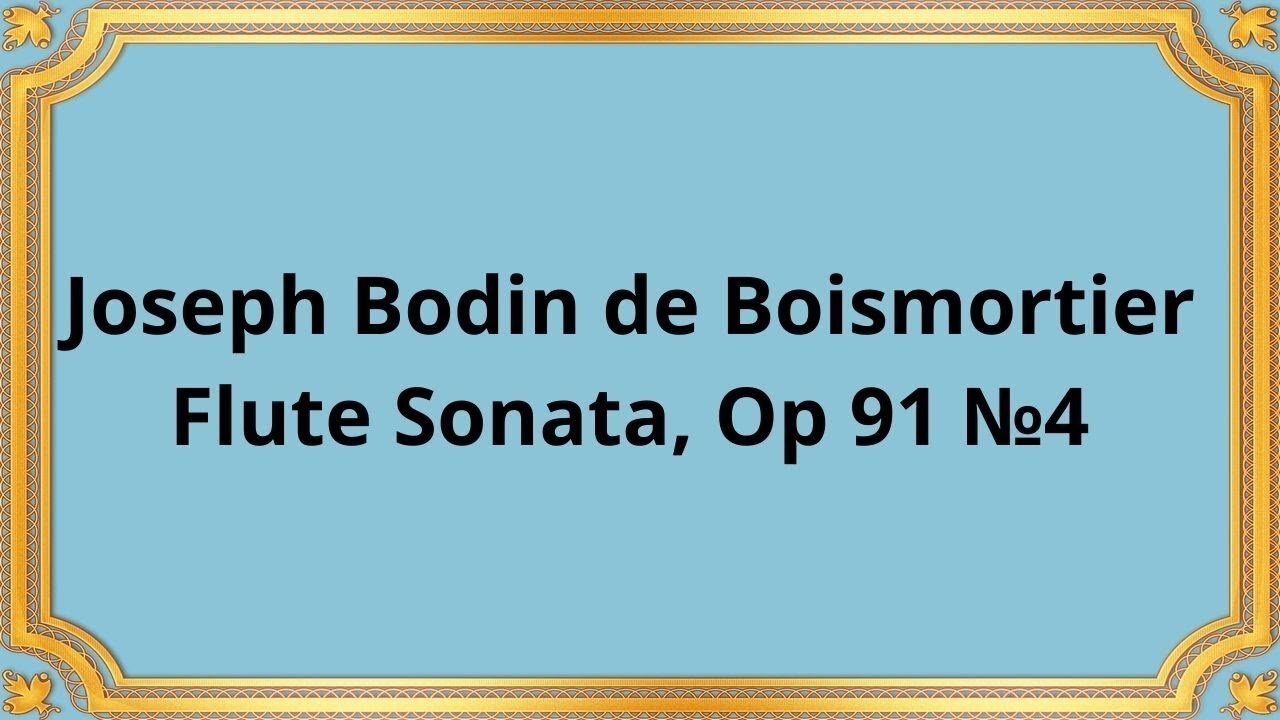Premium Only Content

Joseph Bodin de Boismortier Flute Sonata, Op 91 №4
#Boismortier #FluteSonata #ClassicalMusic #BaroqueComposer #MusicComposition #FluteMusic #ChamberMusic #BaroqueEra #FrenchComposer #Opus91
Rebecca Stuhr Rommereim, baroque flute
John Stuhr-Rommereim, harpsichord
The "Flute Sonata in G major, Op. 91 No. 4" by Joseph Bodin de Boismortier is a captivating musical work that exemplifies the elegance and charm of the Baroque era. Composed specifically for the flute, this sonata showcases Boismortier's exceptional ability to craft engaging and expressive music for the instrument.
Joseph Bodin de Boismortier, a renowned French composer of the Baroque period, made significant contributions to chamber music and composed several works for the flute. The Flute Sonata in G major, Op. 91 No. 4 stands as a shining example of his mastery in creating captivating compositions for the flute.
This sonata adheres to the traditional three-movement structure commonly found in Baroque sonatas. The opening movement, marked "Adagio," introduces a lyrical and expressive melody, allowing the flute to demonstrate its melodic capabilities. The second movement, often labeled "Allegro" or "Presto," is characterized by its lively and spirited nature, showcasing the technical prowess of the flutist. Finally, the sonata concludes with a dance-like movement, typically marked "Allegro" or "Presto," bringing the piece to a jubilant and exhilarating close.
Boismortier's Flute Sonata in G major, Op. 91 No. 4 encapsulates the essence of the Baroque era, featuring ornamented melodies, graceful phrasing, and intricate interplay between the flute and the accompanying basso continuo. The work embodies the spirit of the period, evoking elegance and refined musical expression.
The enduring appeal of this sonata lies in its melodic inventiveness, graceful ornamentation, and the interplay between the flute and the basso continuo, which creates a rich and harmonious tapestry of sound. Boismortier's skillful treatment of the flute as a soloist within the chamber music setting is evident throughout the sonata, showcasing the instrument's versatility and expressive capabilities.
In summary, Joseph Bodin de Boismortier's Flute Sonata in G major, Op. 91 No. 4 stands as a testament to the composer's mastery of the Baroque style and his deep understanding of the flute's expressive potential. Its enduring popularity among flutists, chamber music enthusiasts, and Baroque music aficionados attests to its significance as a cherished work within the genre.
You have the opportunity to support the channel:
https://destream.net/live/RadSiarAl/donate
https://www.buymeacoffee.com/6355radsiaral
-
 14:44
14:44
Classical music_Music Inspiration
1 month agoLudwig van Beethoven Sonata No. 14 in C-Sharp Minor, Op. 27, No. 2 "Moonlight"
62 -
 LIVE
LIVE
Exploring With Nug
8 hours agoHis Truck Was Found Crashed in the Woods… But He’s Gone!
1,223 watching -
 27:09
27:09
MYLUNCHBREAK CHANNEL PAGE
9 hours agoDilmun: Where Life Never Ends
18.2K9 -
 2:59:26
2:59:26
Twins Pod
6 hours agoEMERGENCY PODCAST WITH ANDREW TATE! - Twins Pod - Special Episode - Andrew Tate
53K37 -
 DVR
DVR
Jewels Jones Live ®
2 days agoTRUMP SECURES BORDER | A Political Rendezvous - Ep. 113
25.4K23 -
 25:02
25:02
marcushouse
19 hours ago $33.41 earnedStarship Just Exploded 💥 What Went Wrong This Time?!
93K47 -
 12:00
12:00
Silver Dragons
1 day agoBullion Dealer Reveals Best Silver to Buy With $1,000
50.9K8 -
 12:58
12:58
NinjaGamblers
9 hours ago $11.09 earnedIs This The BEST Way to Win At Roulette? 😲
83.4K7 -
 1:01:54
1:01:54
CharLee Simons Presents Do Not Talk
2 days agoCALIFORNIA'S DONE!
52.3K25 -
 7:33
7:33
MudandMunitions
1 day agoUnboxing My FIRST Revolver! Smith & Wesson 442 .38 Special and What’s Coming Next for the Channel
74K8